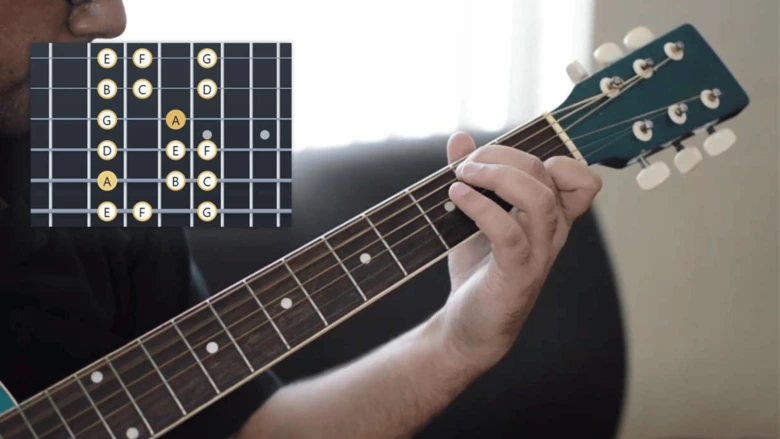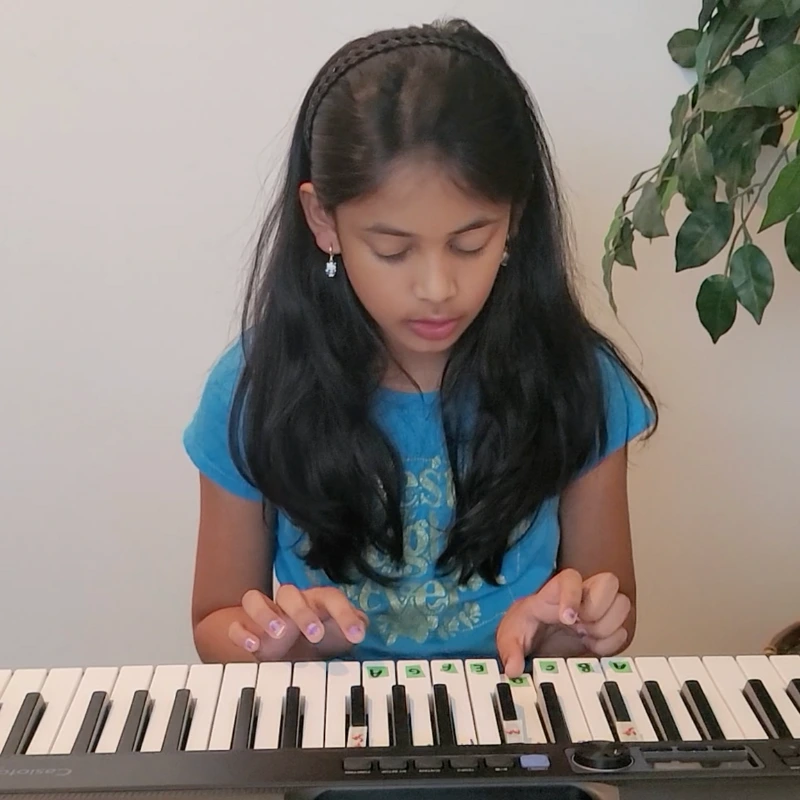One of the first open position guitar scales learnt on the guitar is the A minor scale. It is relatively easy to understand and play on the guitar. Just like the other minor keys, the A minor key is sensibly sad/ominous sounding unlike the major keys/scales. The A minor key has no sharps (#) or flats (♭) just like the C major key and is also the relative minor of C major.
Songs in the key of A minor
There are a lot of songs written in the key of A minor that are very inspiring to learn and play on the guitar. Some of them include really famous rock and pop songs like Stairway To Heaven by Led Zeppelin, The Unforgiven by Metallica, Californication by Red Hot Chilli Peppers, Hurt by Johnny Cash, Ain’t No Sunshine by Bill Withers, House of the Rising Sun by The Animals, The Pretender by Foo Fighters, I Kissed A Girl by Katy Perry, One by U2, and While My Guitar Gently Weeps by The Beatles.
The type of songs mentioned above require prior knowledge of the notes of the A minor scale. Here’s how the notes that make up the A minor scale come into existence.
Notes in the scale of A minor
To formulate the notes in the A minor scale, you need to follow the minor scale formula which involves the use of intervals (space between any two notes). The intervals are in the form of tones and semi-tones. The formula of the minor scales goes like this: tone, semi-tone, tone, tone, semi-tone, tone and tone. You may remember this with the help of the acronym TSTTSTT.

For an easier understanding of the intervals between the notes that form the A minor scale, the notes are played on the open 5th string which is the root note A. Following the minor scale formula, the next note is a tone apart which is logically at the 2nd fret.
The next note is a semi-tone away. So play the note at the next immediate fret (the 3rd fret). The successive two notes are a tone away. Hence these notes are at the 5th and 7th frets. The next note should be at the 8th fret (a semi-tone) according to the formula. The last two notes are two tones higher. So play them at the 10th and 12th frets of the 5th string.
There are no hard-and-fast rules regarding what finger of the fretting hand should be used to play these notes. So you may try them all with just one finger, or use a combination of the pointer-middle fingers or pointer-ring fingers depending on where the notes are on the fret-board. For a better understanding of the notes discussed earlier in the scale of A minor, refer to the tablatures provided below.

Here’s an easier way to remember any of the notes in any minor scale: the 2nd and 3rd notes and 5th and 6th notes are the only two notes with the semi-tone interval. All other notes have a tone interval between them.
You may have found it quite hard to play all these notes across the 12 frets on just one string. This is just to figure out how the A minor scale is created. The A minor scale is not just confined to the notes in this particular octave. There are various scale positions which involve more octaves of notes in the same scale. But these are conveniently confined to a fewer number of frets and involves the use of multiple strings, which is much more practical. The scale positions of the A minor scale are as follows:
A minor Scale positions
1. Open Position
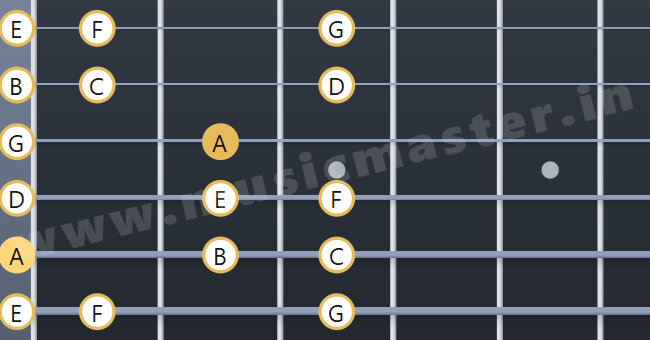
The open position of the A minor scale is the easiest one of all the scale positions due to the inclusion of open strings and overall ease of access. Keep your fretting hand close to the first three frets of the guitar and use just your first three fingers to play the notes on these frets across all the strings on the guitar.
To guide you further, the tablatures for the open position of the A minor scale is provided below. The italic numbers on top of the score tells you which fingers to use to play the notes. This is what those numbers mean:
1 – pointer/index finger 2 – middle finger
3 – ring finger 4 – little finger

2. Second Position
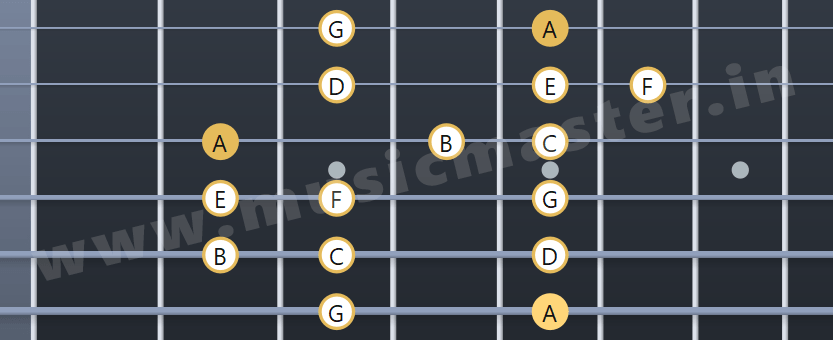
Since some of the notes in this scale shape are located at the second fret on the fret-board, this scale position of the A minor scale is considered to be the second position. You need to reposition your fretting hand up by a fret to access the notes here in the second position of the A minor scale. Just for the notes on the 2nd and 1st strings, move your hand up again by a fret so that the index, ring and little fingers hold down the notes at the 3rd, 5th and 6th frets. Refer to the tablatures below marked with finger numbers in italics to guide you through this scale shape.

3. Fifth Position
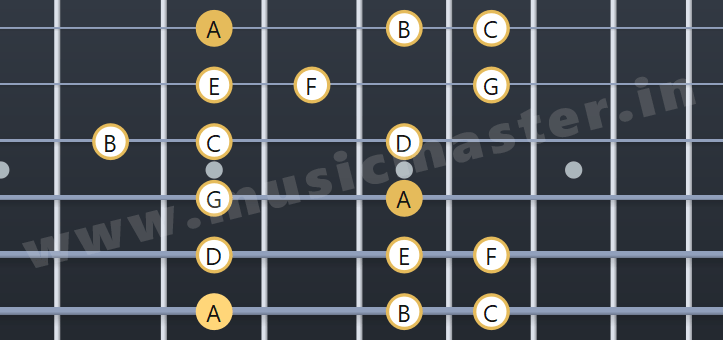
Although there is one note on the 3rd string located at the 4th fret (B), most of the notes on the other strings start at the 5th fret. This leads to the name ‘fifth position’ of the A minor scale. Shift your fretting hand all the way to the 5th fret to play the notes at the 5th, 6th, 7th and 8th frets with your pointer, middle, ring and little fingers except for the three notes on the 3rd string. To play these notes, move your fretting hand down by a fret so that you can use your index, middle and ring fingers to play them.

4. Seventh Position
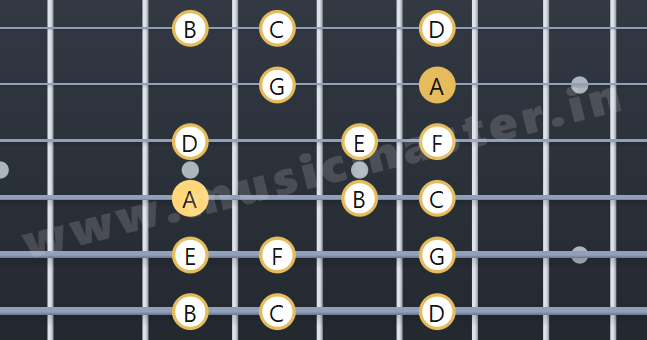
To play the A minor at the seventh position (as the name suggests), bring your fretting hand near the 7th fret in such a way that the pointer, middle, ring and little fingers are able to hold down the notes at the 7th, 8th, 9th and 10th frets respectively. This makes it convenient for the fretting hand since you don’t need to move it up or down to play these notes. Follow the tablatures given below with finger numbers mentioned at the top of the score.

5. Tenth Position
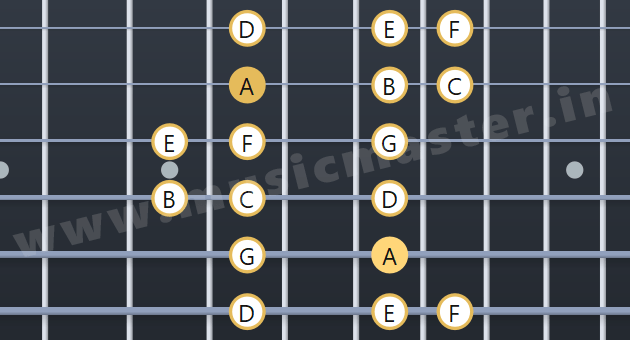
This scale position is a little trickier than the previous one. To play the notes on the 6th and 5th strings, move your fretting hand in a way that your index, ring and little fingers hold down the 10th, 12th, and 13th frets of the guitar. For the next two strings, move your hand down by a fret to play the 9th, 10th, and 12th frets with your pointer, middle and little fingers respectively. For the last three notes located at the 10th, 12th and 13th frets on the 2nd and 1st strings, bring the fretting hand back to the original place to facilitate the use of the pointer, ring and pinkie fingers.

6. Twelfth Position
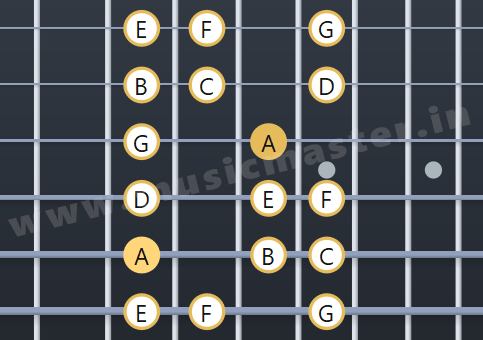
So, this scale position seems to have a similar scale shape as that of the open position. It’s just that the open strings are replaced by the notes on the 12th fret and the notes on the 2nd, 3rd and 4th frets of the open position are played on the 13th, 14th and 15th frets. Even though they are the exact same notes as that of the open position, they are much higher up the neck of the guitar. Hence, they sound higher in pitch too. Just move your fretting hand to the 12th fret and use your pointer, middle, ring and little fingers to play the notes on the 12th, 13th 14th and 15th frets across all the strings.

Once you’ve learned the different scale positions of the A minor scale, try playing the notes in each and every one of them in reverse order. That means you should try starting from the last note of the 1st string and play the successive set of notes one by one until you get to the first note of the 6th string. Keep practicing all these scale positions in both ascending and descending orders to truly master playing the A minor scale all across the fret-board.
Knowing the notes in the A minor scale, you can find the basic note combination to create the A minor chord using the following method:
A minor chord
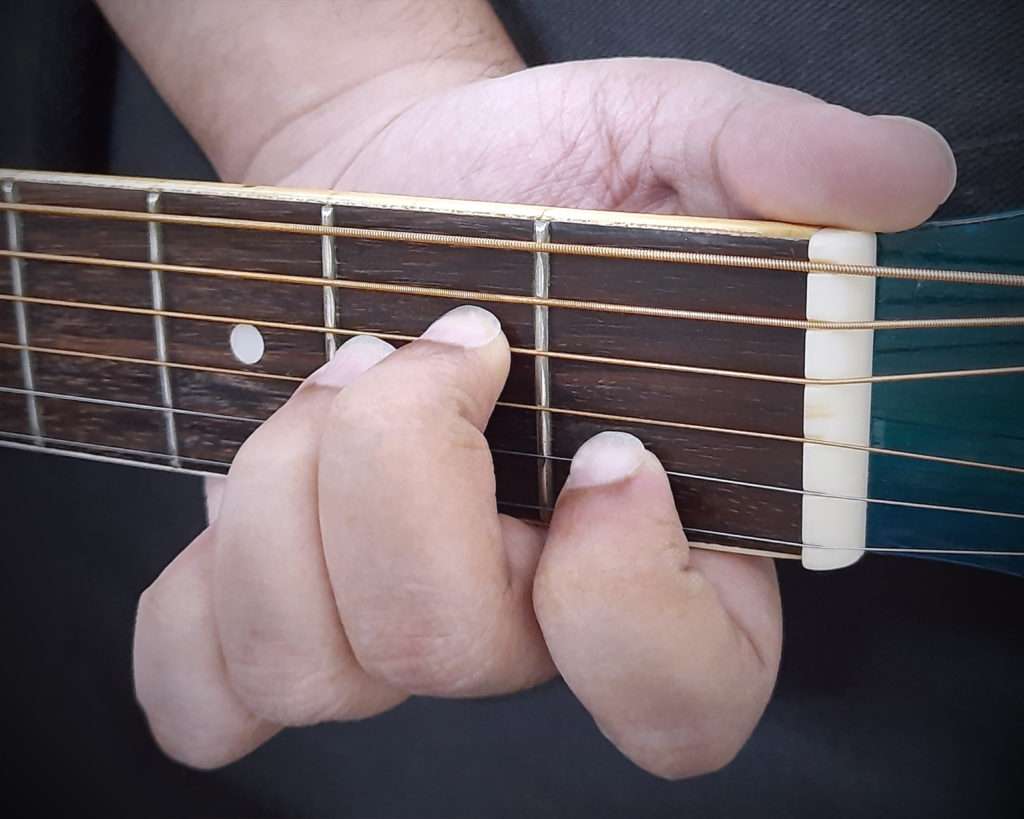
Using the theory of triads, you can come up with the notes required to play any major or minor chord, including the A minor chord. If you recall, a triad is a three-note chord comprising of the 1st, 3rd and 5th notes of the respective scale.
The A minor scale has the note A as the root note. The 3rd note in the scale is C and the 5th note is E. These three notes are combined to create the A minor triad. The chord diagram below illustrates the A minor triad in the open position played on the top three strings.
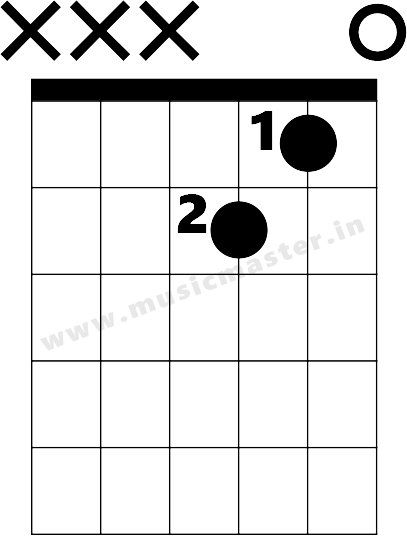
To play the full version of the A minor chord in the open position, hold own the 4th and 3rd string using your middle and ring fingers at the 2nd fret. Now place your pointer on the 2nd string at the 1st fret. With your picking hand strum from the 5th string all the way to the 1st string. Ignore the 6th string completely. Refer to the chord diagram below to have a better understanding as to how to hold this chord.
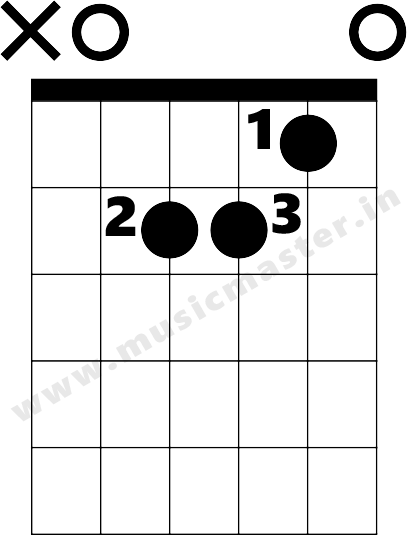
There are a number of chords considered to be theoretically related to the A minor chord. A lot of these chords are also often played with the A minor chord in a number of songs. These are the related chords of the A minor key:
A minor key – Related Chords
1. B Diminished
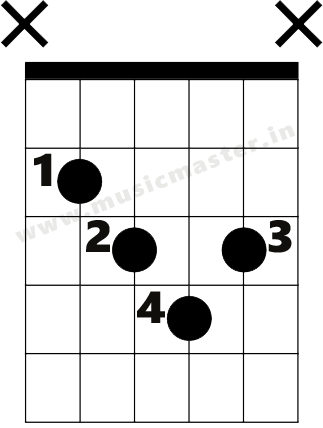
If the 3rd and 5th notes of the major triad are flattened by a semi-tone, then the chord created with these notes are called a diminished chords. So, the B diminished triad consists of the notes B, D and F instead of B, F# and D# found in the B major triad. To play the B diminished chord, start by placing your pointer at the 2nd fret on the 5th string. Next, use your middle finger to press the 4th string at the 3rd fret. Now, put your little finger on the 3rd string at the 4th fret and finally press the 2nd string with your ring finger at the 3rd fret.
2. C Major
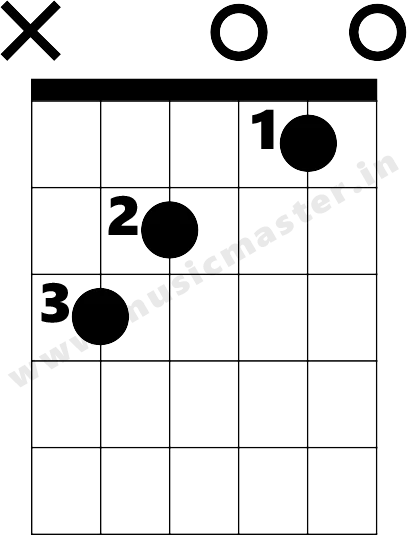
C major is the relative major of A minor. The C major chord can be played in a lot of different ways across different positions all over the fret-board. But, only the open position of this chord come to mind whenever it is mentioned. It’s triad consists of the notes C, E and G. Start by placing your ring finger on the root note located at the 3rd fret of the 5th string. Next, put your middle finger on the 2nd fret of the 4th string. Finally, press the 2nd string at the 1st fret with your pointer, leaving the 3rd and 1st strings open.
3. D Minor
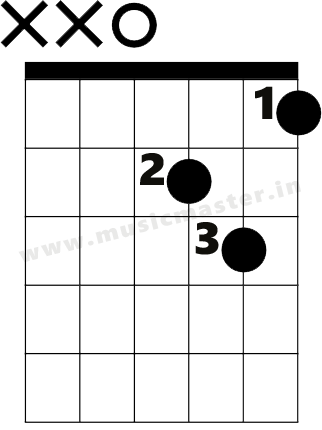
This chord is also quite often played with the A minor chord in a lot of songs. The D minor triad is made up of the notes D, F and A (with D as the root note). The open position of this chord only utilizes 4 strings on the guitar. To hold this chord, start by pressing the 3rd string at the 2nd fret with your middle finger. Use your ring finger to hold down the 2nd string at the 3rd fret. Now, bring your index finger to hold the 1st string at the 1st fret. With the picking hand, strum from the 4th string open all the way to the 1st string. Ignore the 5th and 6th strings.
4. E Minor
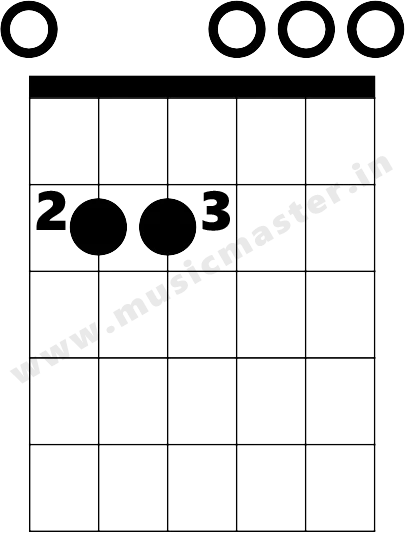
The E minor chord is arguably the easiest chord to play, especially in the open position. You may recall that the E minor triad has the notes E, G and B. It can be easily played by just holding down two strings at the 2nd fret i.e., the 5th and 4th strings with your middle and ring fingers respectively. The picking hand can strum all six strings (four of them are left open). Refer to the chord diagram above to check out how to hold down this really fun and easy chord with your fretting hand.
5. F Major
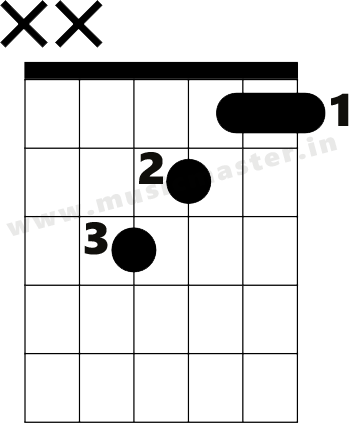
Regularly played with most open chords, the F major chord primarily consists of three notes – F, A and C derived from it’s corresponding triad which in turn is created from three of the seven notes of the F major scale. To play the easiest version of the F major chord, begin by using your ring and middle fingers to hold down the 4th and 3rd strings at the 3rd and 2nd frets. Now flatten your pointer to press down both the 2nd and 1st strings at the first fret. This may be challenging at first, but it will be playable with constant practice.
6. G Major
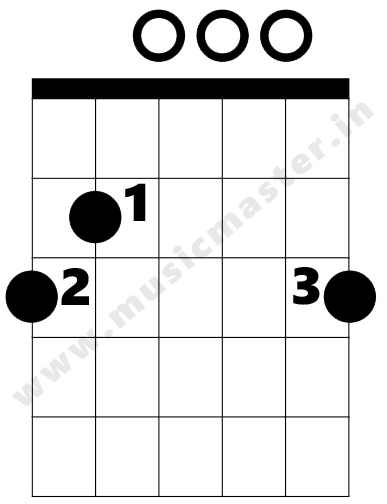
The G major chord is not only a popular chord, it is also one of the easiest open position chords to play on the guitar. It sounds really good together with the A minor chord and other A minor key-related open chord combinations. Start by holding down the 6th string with your middle finger at the 3rd fret. Next, place your pointer at the 2nd fret of the 5th string. Leave the 4th, 3rd and 2nd strings open. Finally, press the 1st string at the 3rd fret with your ring finger.
You may have already come across some of these chords before when dealing with other scale positions. But, it is always a good idea to keep in touch with these chords. If they are new to you, start by holding down the chord positions with your fretting hand. Next, strum the chord with your fretting hand. Reposition your fingers if you find yourself muting the strings. Later on, practice strumming them along with a metronome with a tempo that suits you.
Not all the chords are always played with the A minor chord. For instance, the B diminished chord is actually quite rarely played with any chord, let alone the A minor chord. But, try and find sources, examples or songs where you may find the use of such diminished chords with the other regular chords. It will help keep you inspired to play such dissonant sounding chords and keep these chords in practice as well.

